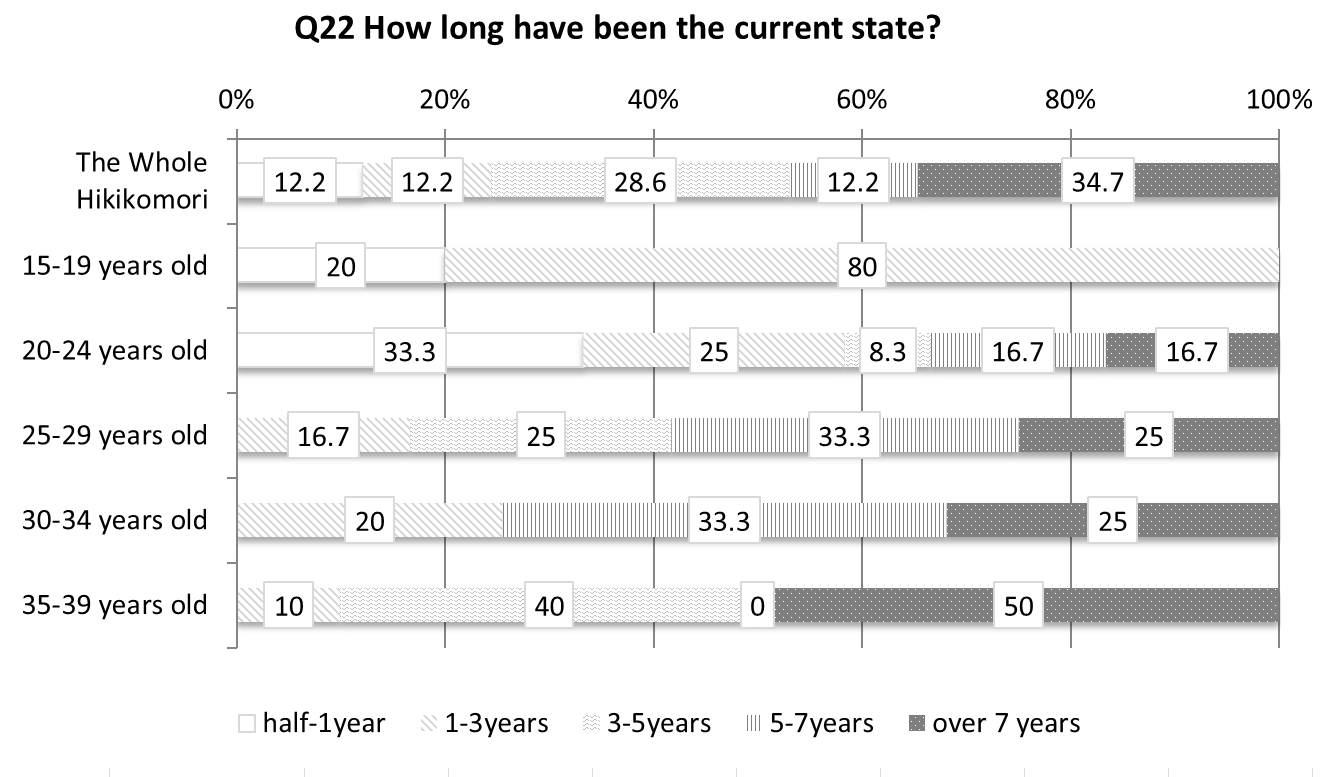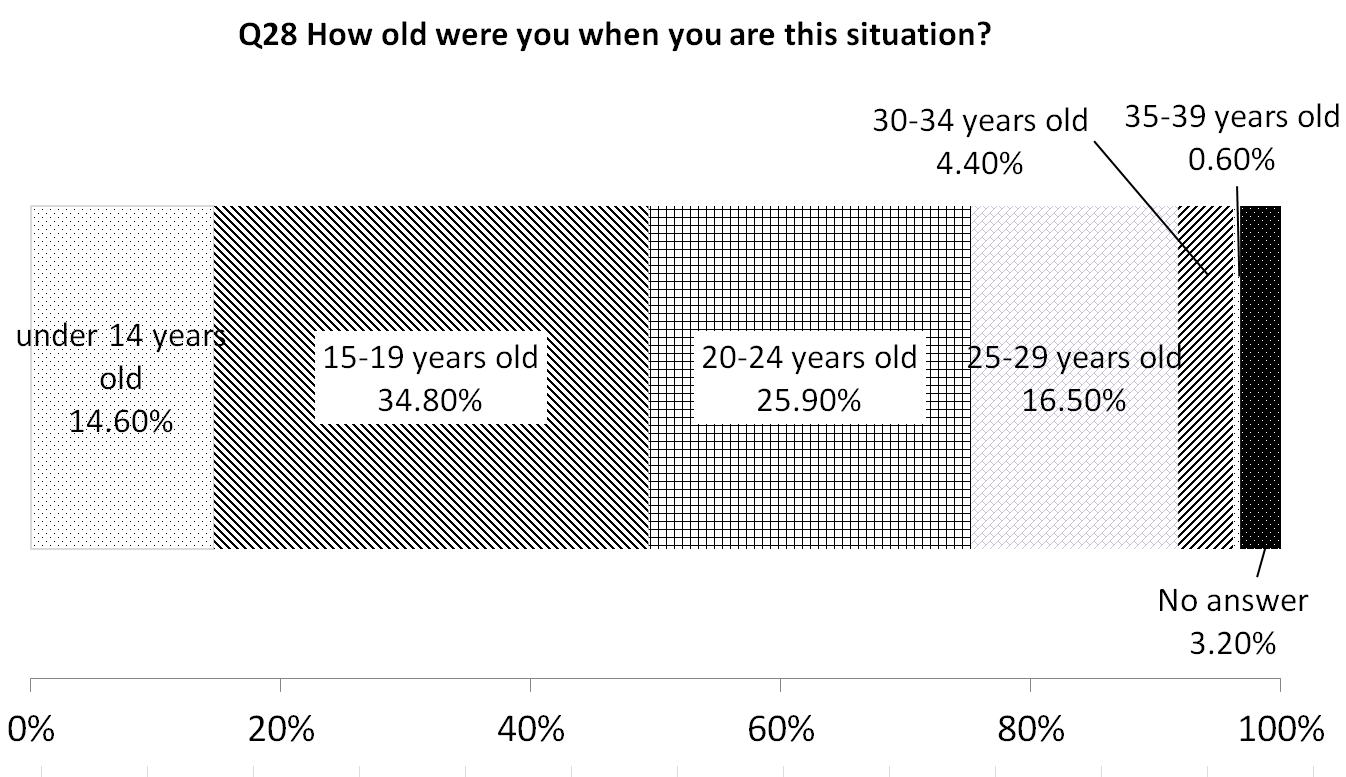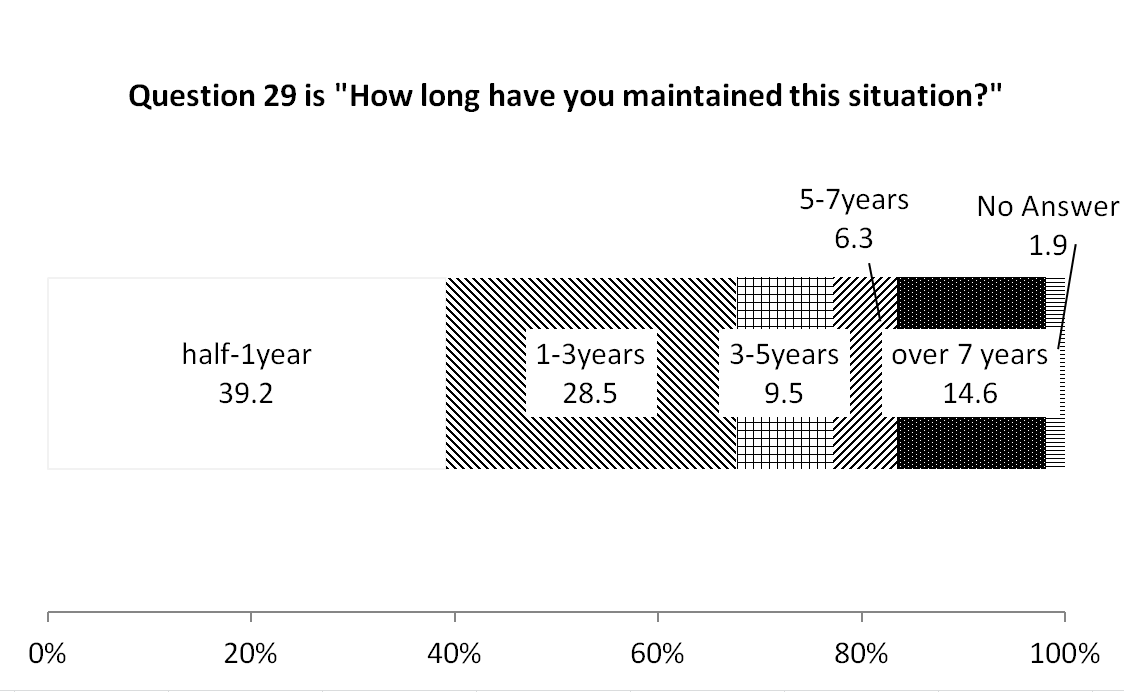日本語 / English

Home > Archive - Investigation of Hikikomori(The Cabinet Office, Government of Japan, 2016)



Reference:Investigation of Hikikomori(The Cabinet Office, Government of Japan, 2016)
The definition of hikikomori in the survey is the same as in the previous investigation (Cabinet Office, Government of Japan, 2010).
The number of people who gave valid responses is 2,905, and 49 (1.69%) meet the definition of hikikomori. According to the Ministry of Internal Affairs and Communications' "population estimates" statistics, there are 3.445 million people aged between 15 and 39 years in the population. The estimation of the number of hikikomori is 541,000 citizens in Japan.
This survey doesn't use "hikikomori"; the name of the investigation is "The survey about the youth life."
The number of people who gave valid responses is 2,905, and 49 (1.69%) meet the definition of hikikomori. According to the Ministry of Internal Affairs and Communications' "population estimates" statistics, there are 3.445 million people aged between 15 and 39 years in the population. The estimation of the number of hikikomori is 541,000 citizens in Japan.
This survey doesn't use "hikikomori"; the name of the investigation is "The survey about the youth life."
The study report judged the status of hikikomori according to choices offered in the twentieth question. Question 20 is the following.
Question 20: How often do you usually go out?
1. I go out to my job or school on every weekday.
2. I go out to my job or school 3-4 days a week.
3. I go out to have fun frequently.
4. I go out to socialize with people sometimes.
5. I go out for hobbies.
6. I go out to neighborhood convenience stores.
7. I go out from my room, but not out from my home.
8. I go out from my room rarely.
1. I go out to my job or school on every weekday.
2. I go out to my job or school 3-4 days a week.
3. I go out to have fun frequently.
4. I go out to socialize with people sometimes.
5. I go out for hobbies.
6. I go out to neighborhood convenience stores.
7. I go out from my room, but not out from my home.
8. I go out from my room rarely.
This survey defines those who chose responses 5-8 as hikikomori.
Result
Geder
| Male | Female | |
| Hikikomori | 63.3% | 48.0% |
| General Population | 48.0% | 52.0% |
About 60% of hikikomori are male; the number of males is larger than that of females in this context. This tendency is the same as that shown in the past investigations.
Age at Present
Table - Age at present| Age Rank | 15-19 years olds | 20-24 years olds | 25-29 years olds | 30-34 years olds | 35-39 years olds |
|---|---|---|---|---|---|
| Hikikomori | 10.2% | 24.5% | 24.5% | 20.4% | 20.4% |
| General Populattion | 18.1% | 16.8% | 17.2% | 22.0% | 25.8% |
About 50% are in their twenties. This research has targeted 15-39-year-olds; it is not clear about over 40-year-olds.
Age Becoming the Present Condition
People who are 15-24 years olds make up over 65%. Many people began hikikomori from adolescence into young adulthood.
Duration of Hikikomori
Question 22: "How long have you been in the current state?"
Over seven years is the most common. Regarding age, we can confirm that hikikomori is prolonged in the elder group.
Over seven years is the most common. Regarding age, we can confirm that hikikomori is prolonged in the elder group.

Experience of Hikikomori
Question 27: "Have you been in the following situations continuously for more than 6 months?"
| I go out for hobbies. | 5.3% |
| I go out neighborhood convenience stores | 1.4% |
| I go out from my room, but not out home | 0.8% |
| I go out from my room hardly | 0.2% |
We estimate, from Question 27, that the number who experience hikikomori is 2.65 million (7.7% of the general population) between 15 and 39 years old.
The target of this question is those who are not in the hikikomori state now. People in the hikikomori situation at present (1.69%) and experienced hikikomori (7.7%) make up 3.235 million. This population is 9.4% of the youth of Japan; almost one in ten Japanese people have experienced hikikomori as a life event. We can recognize that hikikomori is a big and serious social problem.
The target of this question is those who are not in the hikikomori state now. People in the hikikomori situation at present (1.69%) and experienced hikikomori (7.7%) make up 3.235 million. This population is 9.4% of the youth of Japan; almost one in ten Japanese people have experienced hikikomori as a life event. We can recognize that hikikomori is a big and serious social problem.
The age of experiencing the hikikomori state (the group who experienced hikikomori in the past)
Question 28: "How old were you when you were in this situation?"

Duration of hikikomori (the group who experienced being hikikomori in the past)
Question 29: "How long have you maintain this situation?"

Approximately 40% individuals finished hikikomori within one year, and 70% finished being hikikomori within three years. Almost all people succeed in getting away from hikikomori in some years, but 15% people continued over seven years. Some hikikomori periods are protracted.
We can explain that people who experienced being hikikomori form a larger group than people being hikikomori now from this result. Most of the hikikomori recover to society within three years. The number of people with hikikomori experiences reaches the huge number of 7.9%.
The way of this surey
This investigation was conducted as "the Survey about the Youth Life," on 11/12/2015 to 23/12/2015. The samples were 5,000 individuals and their families living together.
The Cabinet Office, Government of Japan, 2011, The survey ablut vonsciousness of youth(The survey actual conditions of hikikomori)>(link, Japanese)
The Cabinet Office, Government of Japan, 2016, The survey about the youth life(link, Japanese)
The Cabinet Office, Government of Japan, 2016, The survey about the youth life(link, Japanese)